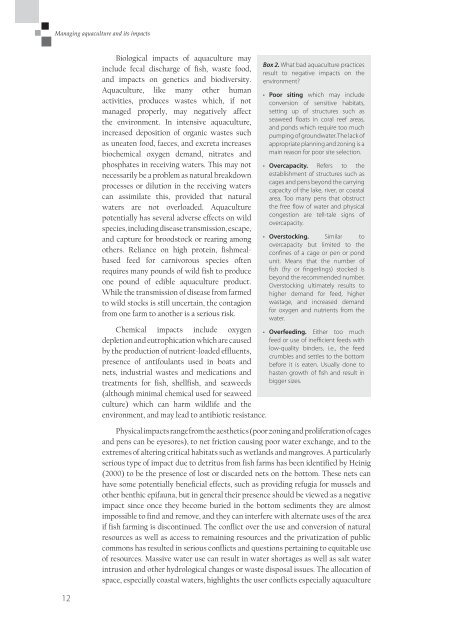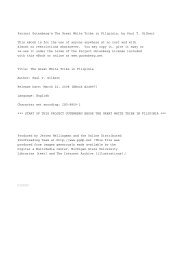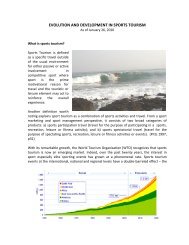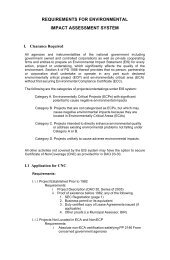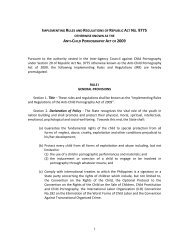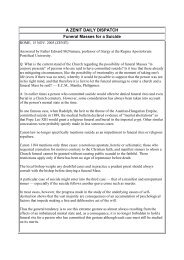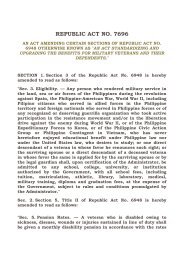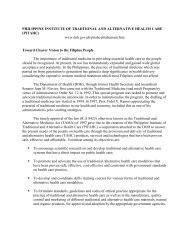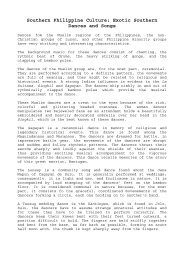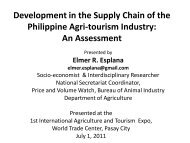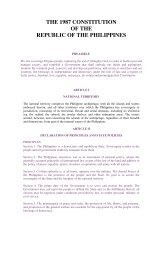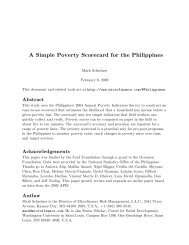Untitled - About the Philippines
Untitled - About the Philippines
Untitled - About the Philippines
Create successful ePaper yourself
Turn your PDF publications into a flip-book with our unique Google optimized e-Paper software.
Managing aquaculture and its impacts: a guidebook for local governments<br />
12<br />
Biological impacts of aquaculture may<br />
include fecal discharge of fish, waste food,<br />
and impacts on genetics and biodiversity.<br />
Aquaculture, like many o<strong>the</strong>r human<br />
activities, produces wastes which, if not<br />
managed properly, may negatively affect<br />
<strong>the</strong> environment. In intensive aquaculture,<br />
increased deposition of organic wastes such<br />
as uneaten food, faeces, and excreta increases<br />
biochemical oxygen demand, nitrates and<br />
phosphates in receiving waters. This may not<br />
necessarily be a problem as natural breakdown<br />
processes or dilution in <strong>the</strong> receiving waters<br />
can assimilate this, provided that natural<br />
waters are not overloaded. Aquaculture<br />
potentially has several adverse effects on wild<br />
species, including disease transmission, escape,<br />
and capture for broodstock or rearing among<br />
o<strong>the</strong>rs. Reliance on high protein, fishmealbased<br />
feed for carnivorous species often<br />
requires many pounds of wild fish to produce<br />
one pound of edible aquaculture product.<br />
While <strong>the</strong> transmission of disease from farmed<br />
to wild stocks is still uncertain, <strong>the</strong> contagion<br />
from one farm to ano<strong>the</strong>r is a serious risk.<br />
Box 2. What bad aquaculture practices<br />
result to negative impacts on <strong>the</strong><br />
environment?<br />
• Poor siting which may include<br />
conversion of sensitive habitats,<br />
setting up of structures such as<br />
seaweed floats in coral reef areas,<br />
and ponds which require too much<br />
pumping of groundwater. The lack of<br />
appropriate planning and zoning is a<br />
main reason for poor site selection.<br />
• Overcapacity. Refers to <strong>the</strong><br />
establishment of structures such as<br />
cages and pens beyond <strong>the</strong> carrying<br />
capacity of <strong>the</strong> lake, river, or coastal<br />
area. Too many pens that obstruct<br />
<strong>the</strong> free flow of water and physical<br />
congestion are tell-tale signs of<br />
overcapacity.<br />
• Overstocking. Similar to<br />
overcapacity but limited to <strong>the</strong><br />
confines of a cage or pen or pond<br />
unit. Means that <strong>the</strong> number of<br />
fish (fry or fingerlings) stocked is<br />
beyond <strong>the</strong> recommended number.<br />
Overstocking ultimately results to<br />
higher demand for feed, higher<br />
wastage, and increased demand<br />
for oxygen and nutrients from <strong>the</strong><br />
water.<br />
Chemical impacts include oxygen • Overfeeding. Ei<strong>the</strong>r too much<br />
depletion and eutrophication which are caused feed or use of inefficient feeds with<br />
by <strong>the</strong> production of nutrient-loaded effluents, low-quality binders, i.e., <strong>the</strong> feed<br />
crumbles and settles to <strong>the</strong> bottom<br />
presence of antifoulants used in boats and before it is eaten. Usually done to<br />
nets, industrial wastes and medications and<br />
treatments for fish, shellfish, and seaweeds<br />
hasten growth of fish and result in<br />
bigger sizes.<br />
(although minimal chemical used for seaweed<br />
culture) which can harm wildlife and <strong>the</strong><br />
environment, and may lead to antibiotic resistance.<br />
Physical impacts range from <strong>the</strong> aes<strong>the</strong>tics (poor zoning and proliferation of cages<br />
and pens can be eyesores), to net friction causing poor water exchange, and to <strong>the</strong><br />
extremes of altering critical habitats such as wetlands and mangroves. A particularly<br />
serious type of impact due to detritus from fish farms has been identified by Heinig<br />
(2000) to be <strong>the</strong> presence of lost or discarded nets on <strong>the</strong> bottom. These nets can<br />
have some potentially beneficial effects, such as providing refugia for mussels and<br />
o<strong>the</strong>r benthic epifauna, but in general <strong>the</strong>ir presence should be viewed as a negative<br />
impact since once <strong>the</strong>y become buried in <strong>the</strong> bottom sediments <strong>the</strong>y are almost<br />
impossible to find and remove, and <strong>the</strong>y can interfere with alternate uses of <strong>the</strong> area<br />
if fish farming is discontinued. The conflict over <strong>the</strong> use and conversion of natural<br />
resources as well as access to remaining resources and <strong>the</strong> privatization of public<br />
commons has resulted in serious conflicts and questions pertaining to equitable use<br />
of resources. Massive water use can result in water shortages as well as salt water<br />
intrusion and o<strong>the</strong>r hydrological changes or waste disposal issues. The allocation of<br />
space, especially coastal waters, highlights <strong>the</strong> user conflicts especially aquaculture


